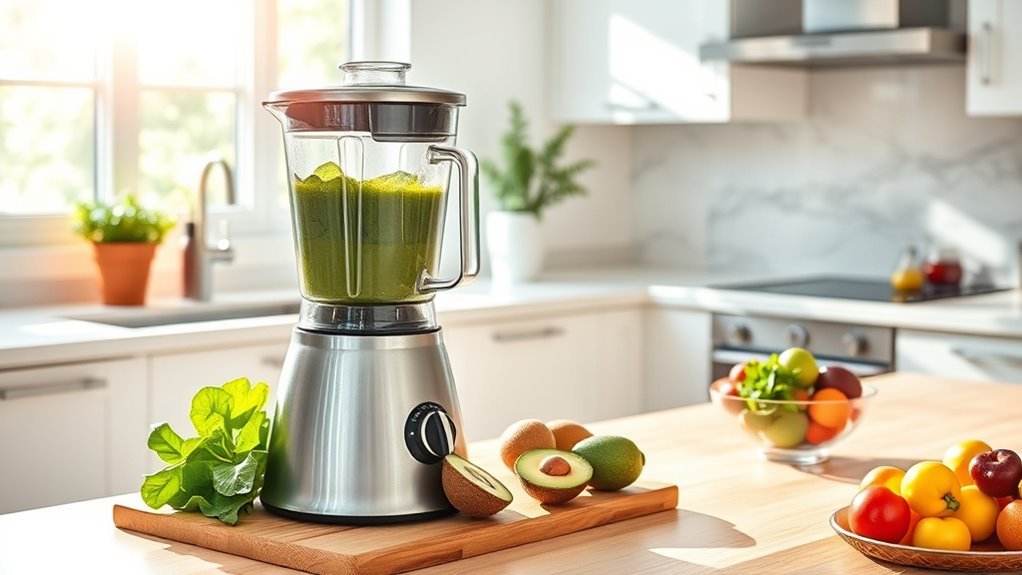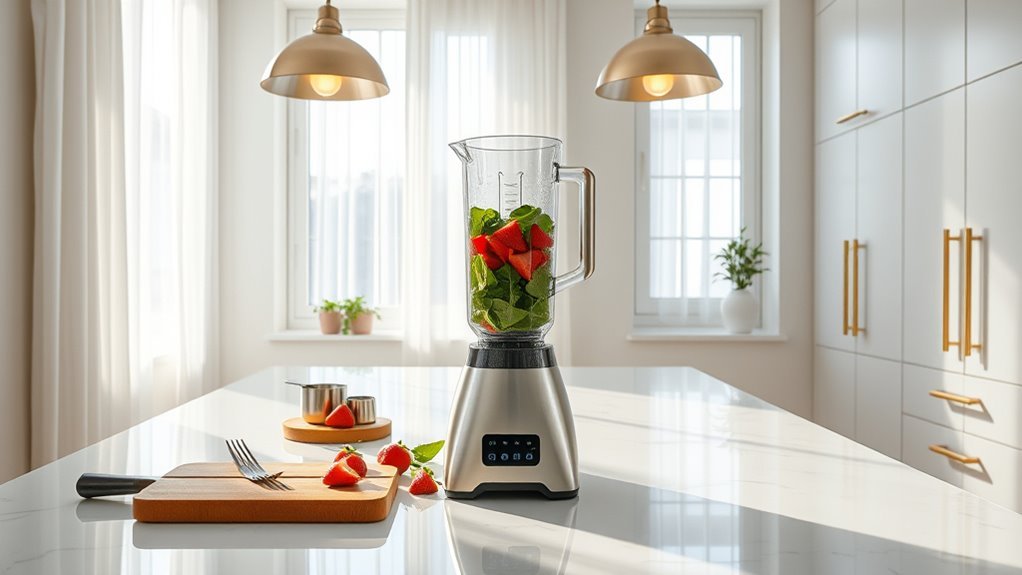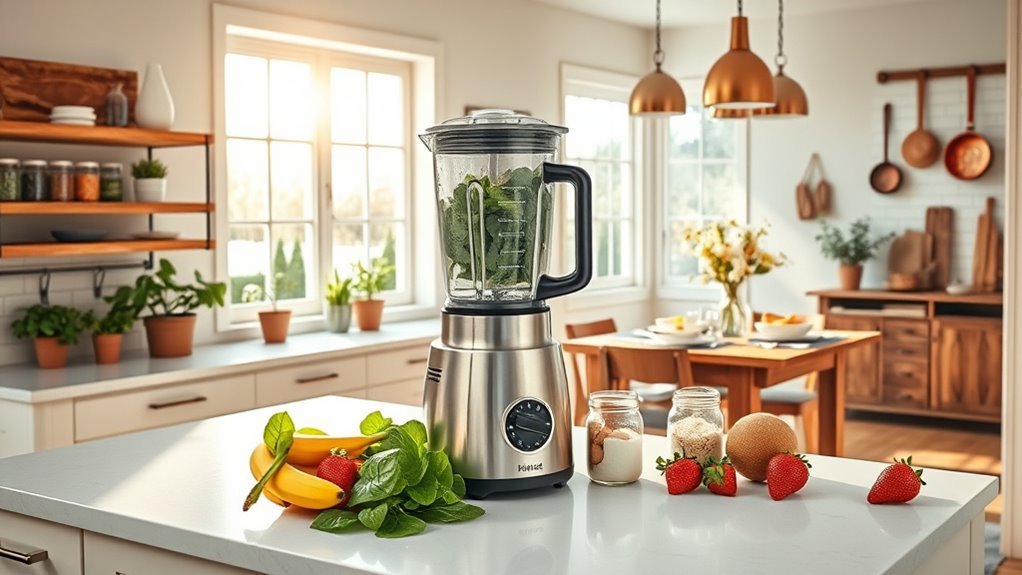Countertop blenders stand like silent kitchen warriors, ready to transform solid ingredients into silky concoctions at the touch of a button. We’ve all faced that moment of indecision while eyeing these appliances in stores or online—they promise so much, but do they deliver? From powerful motors that pulverize ice in seconds to the undeniable counter space they commandeer, we’ll weigh what makes these kitchen workhorses worth the investment…or potentially just expensive dust collectors.
Power and Performance Benefits of Countertop Blenders

Why do we invest in kitchen appliances?
For most of us, it’s about finding tools that make cooking easier and more efficient.
Countertop blenders certainly deliver on that promise with their impressive power and performance.
These kitchen workhorses come equipped with powerful motors ranging from 500 to 1,800 watts.
That high-wattage capability means they’re up to demanding tasks like crushing ice and transforming tough ingredients into silky-smooth creations.
We love how their multiple speed settings—sometimes up to 16 different options—give us precise control over the blending process.
The combination of sharp blades and powerful motors guarantees everything from smoothies to soups reaches that perfect consistency.
And let’s not forget their ability to handle large batches up to 72 ounces, perfect when you’re feeding a crowd!
High-performance blenders are versatile and can make nut butter effortlessly.
Space Requirements and Storage Considerations
While the impressive power and performance of countertop blenders can transform our cooking experience, we can’t ignore the spatial commitment they require in our kitchens.
These stationary appliances aren’t exactly petite roommates—they demand real estate!
When considering countertop blenders versus portable alternatives like stick blenders or personal blenders, here’s what to keep in mind:
- Size matters – With blender jars ranging from 48-72 ounces, you’ll need dedicated counter space
- Weight issues – Unlike 1-2 pound portable models, these heavy-duty appliances aren’t easily relocated
- Storage challenges – Small kitchens struggle with their bulky motor housing and large capacity jars
- Placement needs – You’ll likely need to clear other items when using them
For cramped quarters, we’ve found these spatial demands can sometimes outweigh their impressive performance benefits.
High-performance blenders often feature larger jar capacities, which can further complicate storage in tight kitchens.
Versatility for Different Blending Tasks

How wonderfully adaptable are countertop blenders when it comes to tackling various kitchen tasks!
We’re constantly amazed at how these powerful machines are designed to handle everything from tasks like crushing ice to pureeing hot soups and sauces.
With multiple speed settings (sometimes up to 16!), we can perfectly tailor our blending to whatever we’re making.
Different types of blenders offer varying capabilities, but most countertop models excel at processing frozen fruits for smoothies and creating creamy nut butters.
The preset programs make life so much easier—just press a button and let the blender do its thing!
Perhaps what we love most is preparing large quantities at once.
With capacities up to 72 ounces, we can blend enough for the whole family in one go.
Noise Levels During Operation
When it comes to noise levels, we’ve got to address the elephant in the room—countertop blenders aren’t exactly whisper-quiet kitchen companions!
While a countertop model offers incredible power for blending tough ingredients, that powerful tool comes with a soundtrack.
Here’s what you should know about the noise factor:
- Countertop blenders typically produce much more noise than their immersion blender cousins, especially at high speeds
- High-end models (particularly those with 1,800-watt motors) can be quite disruptive in apartments or early mornings
- Some premium countertop blenders now include sound-dampening features to improve your blending experience
- Hand blenders remain the quieter option if noise is a major concern in your pros and cons list
We’ve found that this is often the deciding factor for many home cooks with noise-sensitive environments.
Cleaning and Maintenance Challenges

Although countertop blenders make quick work of tough ingredients, they present unique cleaning challenges that can test even the most patient home chef.
Those stainless steel blades that pulverize ice and frozen ingredients so effectively can trap food particles in hard-to-reach crevices.
We’ve found that blender jars often require complete disassembly to achieve thorough cleaning—they’re not always as easy to clean as manufacturers suggest.
Many models aren’t fully dishwasher-safe, which is frustrating when you’re dealing with sticky residue from hot liquids or protein shakes.
We highly recommend rinsing immediately after use; otherwise, dried bits can stubbornly stick to blades.
To achieve longevity, make sure you’re following the cleaning instructions specific to your model—stick blenders might be simpler to maintain if counter space is limited.
Cost Analysis: Initial Investment vs. Long-Term Value
Maintaining your blender is one thing, but we should also consider what you’re actually paying for—both now and in the long run.
While countertop blenders come with a higher price tag ($110-$800) compared to portable options, they often prove to be the best blender investment for several reasons:
- Durability – Powerful motors and stainless steel blades handle tough ingredients, saving you from buying replacements if you plan to use it regularly
- Time efficiency – High-capacity designs are ideal for busy households, streamlining meal prep for families
- Feature-rich options – The wide range of speed settings can accommodate everything from smoothies to soups
- Long-term support – Extended warranties and responsive customer service provide peace of mind, even for budget-friendly options
Choose the Right Blender based on how frequently you’ll actually use it—sometimes spending more initially saves money later!
Durability and Lifespan Expectations
The durability of a countertop blender might just be its most underrated feature. We’ve found that blenders with glass jars tend to resist scratches from ice and don’t absorb odors from strong ingredients, while plastic models won’t shatter if you accidentally knock them off the counter.
The most powerful countertop blenders are designed with longevity in mind.
With motors often exceeding 1,000 watts, these kitchen appliances can handle tough ingredients like frozen fruits day after day. The sharp blades, typically made of stainless steel, resist rust and stay effective for years.
When you regularly use a blender, warranty length matters too. A longer warranty usually signals that blenders are designed to last—manufacturers wouldn’t offer it if they expected early failure!
Frequently Asked Questions
What Are the Disadvantages of Portable Blenders?
We’ve found portable blenders suffer from power limitations, capacity issues, battery drain, and mixing inefficiency. They’re also plagued by durability concerns, cleaning challenges, noise levels, heat generation, storage problems, and cost burdens.
Is a Countertop Blender Better Than a Blender?
Like comparing apples to apples! We’d say countertop blenders excel with superior power comparison, larger capacity size, advanced speed features, better motor efficiency, and higher performance rating than portable alternatives—despite higher price points.
What Are the Disadvantages of a Blender?
We’ve found blenders have several disadvantages: noise pollution, cleaning hassle, space requirements, cost factors, safety risks, maintenance needs, energy consumption, durability issues, overheating problems, and texture inconsistencies when processing certain ingredients.
Are Portable Blenders Better Than Regular Blenders?
Like a Swiss Army knife in your bag, portable blenders offer travel versatility and size advantages, but we can’t say they’re better—just different. Their battery efficiency and design innovation suit on-the-go usage scenarios despite lower power capabilities.

